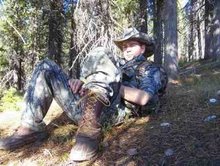Rocky Mountain Elk Foundation Signs Habitat Stewardship Contracting Agreements with U.S. Forest Service and U.S. Bureau of Land Management
FOR IMMEDIATE RELEASE
Contact: Mark Armstrong, Rocky Mountain Elk Foundation
406-523-3431 or marmstrong@rmef.org
December 15,2006
Rocky Mountain Elk Foundation Signs Habitat Stewardship Contracting Agreements with U.S. Forest Service and U.S. Bureau of Land Management
Historic Agreement Will Allow Elk Foundation and Partners to Enhance Nearly 260,000 Acres of Elk Habitat in Montana and Wyoming
(Dec. 15, 2006) Missoula, Mont. — The Rocky Mountain Elk Foundation signed agreements today with the U.S. Forest Service and U.S. Bureau of Land Management to conduct two 10-year habitat stewardship projects on nearly 260,000 acres of federal land in Montana and Wyoming.
Signing the agreements opens the door for the Elk Foundation and its partners to begin work to improve wildlife habitat on 85,000 acres of Forest Service Land bordering the Blackfoot Clearwater Wildlife Management Area near Ovando, Montana, and 174,000 acres of BLM land in the Wyoming Range west of Pinedale, Wyoming.
Stewardship contracting is a relatively new authority that Congress granted to the Forest Service and the Bureau of Land Management to manage and restore federal lands. This authority allows agencies to reinvest some or all of the value of commercial timber or other forest products into habitat stewardship projects, accomplishing more on the ground for wildlife and other resources than is possible with congressionally appropriated funds alone. In a time of increasing budget constraints for federal agencies, stewardship contracting allows habitat projects to proceed that may otherwise not have been possible.
“Stewardship is a way of doing our business that helps us to do more good work on the land,” said Dale Bosworth, Chief of the U.S. Forest Service. “It provides a new way to involve communities and organizations such as the Elk Foundation in carrying out our collective mission of caring for the land. I want to thank the Foundation for its dedication to the concept of stewardship and its willingness to invest its energy and resources to bring this agreement to a conclusion.”
The two projects, officially called stewardship agreements, put conservation concerns at the forefront, but still acknowledge the importance of harvesting timber. The projects provide all parties the opportunity and tools to study a landscape and develop a long-range plan that will help meet objectives for healthy forests, biological diversity and habitat conditions for desired wildlife.
“Stewardship contracting is a new way for federal agencies, communities, conservation organizations and industry to work in partnership for the benefit of the land and wildlife,” said Peter J. Dart, President and CEO of the Rocky Mountain Elk Foundation. “The Elk Foundation is truly honored to be the partner to lead these important, landscape-scale projects.”
The Forest Service agreement with the Elk Foundation is on the Seeley Lake Ranger District of the Lolo National Forest — an area that provides a key migration corridor for elk and mule deer between their summer range high in the Bob Marshall Wilderness and their winter range on the 57,000-acre Blackfoot-Clearwater Game Range.
The Elk Foundation, working with many conservation and industry partners, will spearhead habitat stewardship projects such as selective logging and thinning operations, noxious weed treatment and seeding.
“I want to congratulate the BLM’s Wyoming State Office and the Rocky Mountain Elk Foundation for developing this Stewardship Agreement,” said BLM Director Kathleen Clarke. “This joint effort will not only strengthen our management and protection of wildlife habitat in Sublette County, but will also advance the BLM’s overall mission of ensuring the health and productivity of the nation's public lands.”
The primary objective of the Elk Foundation’s habitat stewardship agreement with the Bureau of Land Management in Wyoming is to promote the restoration of age and size/class diversity of aspen stands. Aspen communities are considered second only to riparian and wetland communities as the most productive habitat for wildlife and plant diversity in the Rocky Mountain region. Aspen stands within the project area are spread across 174,000 acres of elk country and provide some of the region’s most vital habitat for elk, mule deer and other wildlife.
As the lead agreement partner, the Elk Foundation will subcontract out the work to timber and forest restoration companies, and other community and conservation organizations. The work will take place over the next 10 years and will include removing conifers, thinning aspen and prescribed burning to stimulate aspen growth.
About the Rocky Mountain Elk Foundation
Founded in 1984 and headquartered in Missoula, Mont., the Rocky Mountain Elk Foundation is a nonprofit organization dedicated to ensuring the future of elk, other wildlife and their habitat. The Elk Foundation and its partners have permanently protected or enhanced more than 4.7 million acres, a land area nearly twice as large as Yellowstone National Park. More than 450,000 acres previously closed to public access are now open for hunting, fishing and other recreation. To help protect wild elk country or learn more about the Rocky Mountain Elk Foundation, visit www.elkfoundation.org or call 800-CALL ELK.
